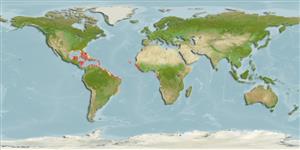Environment: milieu / climate zone / depth range / distribution range
Οικολογία
Θαλασσινό(ά) Υφαλόφιλο(α); εύρος βάθους 1 - 26 m (Ref. 89885), usually 1 - 2 m (Ref. 89885). Tropical
Western Atlantic: Eastern Atlantic and Brazilian populations need further investigation, (including morphological and genetic), to determine if they represent R. subbifrenatus or undescribed species (Ref. 89885).
Μέγεθος / Βάρος / Age
Maturity: Lm ? range ? - ? cm
Max length : 18.0 cm TL αρσενικό/απροσδιόριστο; (Ref. 7251)
Ραχιαίες άκανθες (συνολικά): 3 - 4; Μαλακές ραχιαίες ακτίνες (συνολικά): 21-25; Εδρικές άκανθες 1; Μαλακές εδρικές ακτίνες: 11 - 13. This species is distinguished from its congeners by the following set of characters: pectoral fin and distal portions of soft dorsal, caudal, and anal fins are tan to brown in life and when preserved; numerous dark spots on head and trunk; spots on head posterior to horizontal through center of orbit usually prominent, round or oblong, and one or more usually equal in size to or larger than diameter of pupil; posterior portion of interorbital region usually with 2 pairs of spots (sometimes joined as a stripe), spots directly on or abutting orbital rim; belly and caudal fin usually without spots; D III or IV (nearly bimodal), total dorsal-fin elements modally 26; pectoral fin rays modally 16; total caudal-fin rays modally 25; lower jaw extending anteriorly beyond upper jaw, mean difference between distance from tip of lower jaw to orbit and tip of upper jaw to orbit 4% HL; caudal peduncle relatively wide, average depth 13% SL (Ref. 89885).
Inhabits clear tropical waters to depths of 26 m, but it is found most commonly at 1-2 m (mean maximum depth of specimens collected is 5 m, only 6 were captured deeper than 15 m). Lives in tide pools, among coral rubble, in patch reefs and shallow spur and groove reef areas, occasionally found on steep vertical walls (Ref. 89885). A solitary species (Ref. 26340). Adults are said to prefer clearer waters than juveniles (Ref. 7320).
Life cycle and mating behavior
Γεννητική Ωρίμανση | Αναπαραγωγή | Γεννοβολία | Αβγά | Γονιμότητα | Προνύμφες
Maugé, L.A., 1990. Grammistidae. p. 709-710. In J.C. Quero, J.C. Hureau, C. Karrer, A. Post and L. Saldanha (eds.) Check-list of the fishes of the eastern tropical Atlantic (CLOFETA). JNICT, Lisbon; SEI, Paris; and UNESCO, Paris. Vol. 2. (Ref. 7320)
IUCN Red List Status (Ref. 130435)
Threat to humans
Harmless
Human uses
αλιεία: Εμπορικό(ά)
Περισσότερες πληροφορίες
Κοινά ονόματαΣυνώνυμαΜεταβολισμόςΘηρευτέςΟικοτοξικολογίαΑναπαραγωγήΓεννητική ΩρίμανσηΓεννοβολίαΣυναθροίσεις γεννοβολίαςΓονιμότηταΑβγάEgg development
ΑναφορέςΥδατοκαλλιέργειεςΠροφίλ υδατοκαλλιέργειαςΣτελέχοιΓενετικήElectrophoresesΚληρονομικότηταΑσθένειεςΜεταποίησηNutrientsMass conversion
ΣυνεργάτεςΦωτογραφίεςStamps, Coins Misc.ΉχοιΣιγκουατέραΤαχύτηταΚολυμβητικός ΤύποςΕπιφάνεια βραγχίωνOtolithsΕγκέφαλοιΌραση
Εργαλεία
Special reports
Download XML
Διαδικτυακές πηγές
Estimates based on models
Preferred temperature (Ref.
123201): 25.5 - 28.1, mean 27.4 °C (based on 888 cells).
Phylogenetic diversity index (Ref.
82804): PD
50 = 0.5010 [Uniqueness, from 0.5 = low to 2.0 = high].
Bayesian length-weight: a=0.01148 (0.00451 - 0.02922), b=3.06 (2.84 - 3.28), in cm total length, based on LWR estimates for this (Sub)family-body shape (Ref.
93245).
Τροφικό Επίπεδο (Ref.
69278): 3.8 ±0.7 se; based on size and trophs of closest relatives
Fishing Vulnerability (Ref.
59153): Low vulnerability (10 of 100).
Nutrients (Ref.
124155): Calcium = 71.5 [39.3, 138.8] mg/100g; Iron = 0.645 [0.335, 1.129] mg/100g; Protein = 18.6 [16.8, 20.3] %; Omega3 = 0.167 [0.105, 0.265] g/100g; Selenium = 23.3 [13.0, 44.2] μg/100g; VitaminA = 142 [46, 462] μg/100g; Zinc = 1.32 [0.89, 1.93] mg/100g (wet weight);
